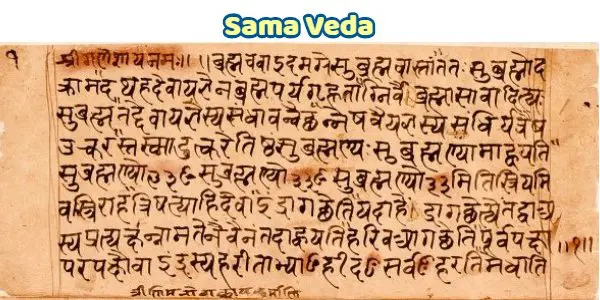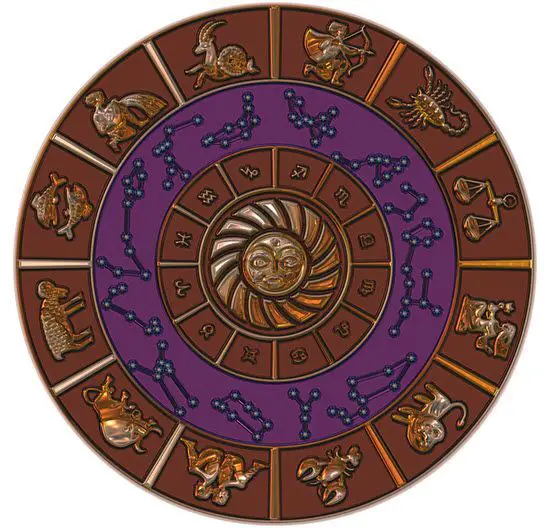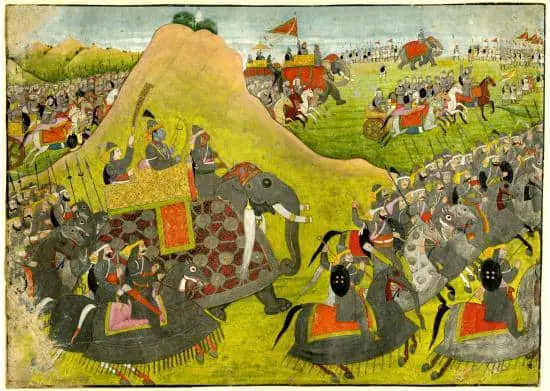Sama Veda is an ancient Vedic Sanskrit Text. It is one of the four Vedas; other Vedas include Rig Veda, Atharva Veda, and the Yajur Veda.
In fact, Samaveda is the shortest of all the four Vedas. It consists of 1549 verses. As of now, only three recensions of the Samaveda have survived.
This post is about Sama Veda and its Teaching.
Table of Contents
What is Sama Veda?
Sama Veda is the Veda of melodies and chants. It is believed that the Samaveda was compiled during 1200 or 1000 BCE. It holds a divine status in the Hindu tradition.
In fact, in the Bhagavad Geeta, Lord Krishna has described the Samaveda is the most important of all the Vedas.
Sama Veda is exclusively compiled for ritual application. Its verses were chanted at the ceremonies such as the Soma-sacrifice. It praises deities such as Indra, Agni, and Soma. Moreover, its prayers are dedicated to invoking the Supreme Being.
Here, the major theme is centered on worship and devotion. It believes that the Glorious Lord and Brahman are attainable only through devotion and musical chanting.
According to Sage Patanjali, the Samaveda had 1000 recensions (Shakhas). However, as of now, only three recensions have survived. These are known as:
- Kauthuma
- Jaiminiya
- Ranayaniya
Out of these, the Kauthuma Shakha is the most prominent one. It consists of two parts:
- Archika
- Gana
The Archika is divided into two parts:
- Purvarchika
- Uttararchika
Its first part (Purvarchika) contains four parts:
- Agneya: 114 verses for Agni
- Aindra: 352 verses for Indra
- Pavamāna: 119 verses for Soma
- Aranya: 55 verses for Indra, Agni, Soma, etc.
The Uttararchika contains a total number of 1225 verses.
The Gana part of the Samaveda has also been divided into Prakriti Gana and Uha Gana.
The Sama Veda also contains Chandogya Upanishad and Kena Upanishad.
All in all, Sama Veda is the Veda of Chants. It is the storehouse of knowledge of chants.
There have been many schools of thought on the origin of Sama Veda. For example, according to the Satapatha Brahmana, The Samaveda originates from the Sun, which has been embodied by the deity Surya.
Moreover, the Sama Veda is not supposed to be a monolithic text. It is rather comprised of a number of texts that have been written over a large period of time.
It comprises of Samaveda “Samhita,” which contains hymns in a ritual context. A vast majority of Sama Veda Samhita has been dedicated to the praise of Agni, Indra, and Soma.
The veda also contains a Brahmana, which describes the necessary procedures that are to be followed before as well as during the chanting of the Samaveda Samhita.
It sets the standards for the proper recitation of the Samhita. It also contains topics centering on social customs as well as countering bad omens.
As stated earlier, the Sama Veda also contains the Upanishad known as the Chandogya Upanishad. It includes commentaries on the syllable Om, which is a sacred utterance in the Hindu tradition.
Here, Om has been described as the source of being, which is superior to any ritual. It also contains the famous story of Uddalaka and Shvetaketu.
So, Samaveda holds an important place in the Hindu context. It has shaped Hindu beliefs and practices down the centuries.
Samaveda Meaning
Sama Veda is an ancient Hindu Vedic Scripture. It is one of the four main Vedas of Hinduism. It contains a collection of melodies and chants.
Sama means “melody,” and Veda means “knowledge.” Samaveda has been described as the “Book of Song” or “The Veda of Chants” or even as the “Yoga of Song.”
It basically contains the words of Rig Veda in music. So, Sama Veda is not recited or read but sung. It contains about 1900 verses which have been taken from the Rig Veda.
It has been formed by assigning music to the mantras in Rig Veda. In fact, the system of music has emerged from Sama Veda. The Samaveda Mantras are used in Yagna.
What does Sama Veda teach?
The hymns of Sama Veda, when sung in the appropriate manner, enable you to understand the universal truths. In fact, the musical patterns in Samaveda have been derived from the vibrations of the cosmos.
So, Sama Veda helps you to attain spiritual evolution through music. It represents the force of spiritual knowledge.
Moreover, the Sama Veda was used in Soma sacrifice. In fact, Samaveda has been described as the Veda of Bhakti. Its hymns were used in religious ceremonies.
In Bhagavad Gita, Lord Krishna says, “Of the Vedas, I am Sama.”
Sama Veda is the source of Indian Classical Music.
“Richas” (shlokas) form the basis of Samaveda. The incantations of Sama Veda can bless you with divine peace. It praises Agni (fire) to destroy the demons and bless us with wealth. Agni is the giver of happiness. It is described as the lord of good fortune.
Some other teachings of Sama Veda include:
- Through cleanliness, you can keep away diseases
- One who does not keep “Vrata” can never accomplish anything
- A scholar of knowledge can defeat all his enemies
- Perform virtuous deeds to become great
- One who wears gems possesses wealth
- People who have double standards never experience happiness
- “Fire of Tapa” helps you to achieve great heights
- Knowledge of scholars can help the ignorant to attain supremacy
- Salvation can be achieved through the path of progress
- The night is the provider of rest and relaxation
- Agni (fire) is pure and benedictory
- A man with self-control becomes the master
- Yagya enlightens the flames of consciousness in the human’s mind
- Soma ignites in us the enthusiasm to win
- Deities bless the diligent
- A truthful person’s speech is like honey
- Never be in the company of those who hate knowledge
- Never listen to whatever is evil
- Engage yourself in auspicious activities
- You fight a battle every day
- Agni helps all to settle well
- Tread on the path of truthfulness
- One can accomplish great deeds with the help of truth
- Adorn your speech
- There are ten characteristics of “Dharma” – Stability of mind, Purity, Forgiveness, Abstinence, Benevolence, Control of Senses, Intellect, Truth, Knowledge, and abstinence from anger
- Indra and Agni are the embodiments of joy
- Protect your children using your own efforts
- The great “Surya” illuminates heaven
- Never fall prey to your pride
- May the brilliant men of capabilities inspire us
- Look at the divine deeds of Vishnu, contemplate and then follow them
- O, men! Move ahead and be a winner
- Moreover, much more
Who wrote the Sama Veda?
The Vedas (including the Samaveda) are considered to be “Apauruseya,” meaning “not of a man, superhuman” and “impersonal, authorless.”
The Hindu Epic Mahabharata credits the creation of the Vedas to Brahma. According to tradition, Vyasa is supposed to be the compiler of Vedas in the form of Rig Veda, Yajur Veda, Sama Veda, and Atharva Veda.
So, that’s all in this post on Samaveda and its teaching. We hope that the post has provided useful insights into Sama Veda and its teaching. Thanks for visiting. We welcome your comments and suggestions. Please share the post across popular social networking sites.





